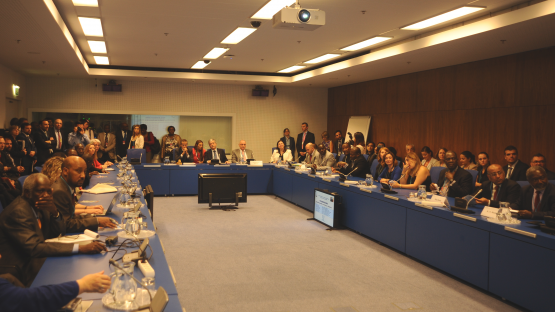Advances in communication technology provide opportunities to offer radiation medicine services to many who live too far from quality treatment centres or do not have the means to use one. Whether performing check ups over the Internet, or having a consultation with professionals from abroad, health care providers are making increasing use of these new tools to increase access to radiation medicine.
“Health workers save lives — maternal survival, infant survival, child survival, all increase with higher health care workforce densities — but unfortunately, the workforce is not evenly distributed and there are inequalities in access,” said Yunkap Kwankam, Executive Director of the International Society for Telemedicine and e-Health, who presented at a side event on ‘Telemedicine: Providing Health Services at a Distance’ held yesterday on the margins of the IAEA’s 59th General Conference. With telemedicine, “rather than take your health problem to where the solution exists, the effort now is to make those solutions available wherever the need arises.”
Telemedicine is a way to provide medical services at a distance. It relies on a comprehensive set of communication and information tools, ranging from basic telephones and internet connections, to satellite connections and video conferencing equipment. Many of these tools, including specialized medical equipment like small sensors and scopes, are compact, can be battery-powered, and can fit in a small briefcase, making them easy for health workers to transport and use in remote, harder-to-reach areas.
Practitioners use these tools to connect across the globe to discuss, consult on, and outline plans of action on patient cases, to learn from other experts, and, in some situations, remotely monitor a patient’s health using sensors or perform remote medical procedures and examinations. They can be used in radiation and nuclear medicine, and a variety of other medical areas, to treat a range of diseases and health conditions.
For cancer, for example, using telemedicine to connect radiotherapy treatment centres can be a cost-effective way to fill workforce gaps and provide a full range of access to treatment, explained Niloy Datta, a radiation oncologist at the Centre for Radiation Oncologyat Kantonsspital Aarau in Switzerland.
“We know there is a silent crisis: cancer. There is a deficiency of radiation oncologists, of teletherapy units, medical physicists, and radiation therapy technologists [in low and middle income countries], and this is only going to increase,” Datta said.
Creating a network between clinics that provide three different levels of care and connecting them using telemedicine, a patient can move seamlessly from one clinic to another to get the care they need. “All the centres are networked so they are talking with each other. So you are basically pooling and sharing the resources, the patient has access to the entire network, and it improves the outcomes and quality,” he said.
Creating connections for better coverage
Networks connected using telemedicine is a central part of Argentina’s CyberHealth project to strengthen the country’s health care system. Juan Carlos Furnari, Head of the Nuclear Technology Applications Area of Argentina’s Atomic Energy Commission, explained how this project will help them to improve the health care coverage in Argentina.
“There is a strong policy of social inclusion in our country. All people with or without resources, should have access to high-tech nuclear technology applied to health,” said Furnari. Through installing 30 000 kilometres of fibre optic cabling and upgrading health facilities with video conferencing equipment and software, state and national reference hospitals, universities and research institutes, local health centres, including the country’s first proton therapy centre, will be connected throughout the country, he said.
“Today we have 230 health centres connected, and by the end of 2015, we expect to have 325 health centres connected, providing health coverage for 95% of the population,” Furnari said.
Through training, technical meetings and projects, the IAEA helps Member States to develop their abilities to use telemedicine. While the Agency’s activities in medicine focus on nuclear and radiation tools and techniques, the use of telemedicine extends beyond these atomic-related areas, explained Rajiv R. Prasad, radiation oncologist at the IAEA.
“The IAEA helps Member States collaborate both online and offline for applications in health in general and in radiation medicine in particular,” said Prasad. “We help Member States to connect to each other to exchange ideas and improve their knowledge base, as well as to setup networks for sharing human resources and to provide patients with the care they need.” The Agency itself shares knowledge and expertise by using telemedicine, including through online consultation meetings, webinars, recorded seminars and other forms of e-learning platforms, he added.
The IAEA has also helped establish and run the virtual Africa Radiation Oncology Network (AFRONET), through which professionals in radiotherapy centres in English-speaking Africa discuss individual cases and reach a consensus on treatment.
All people with or without resources, should have access to high-tech nuclear technology applied to health.



